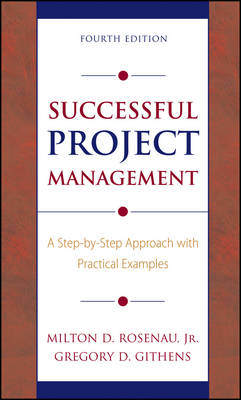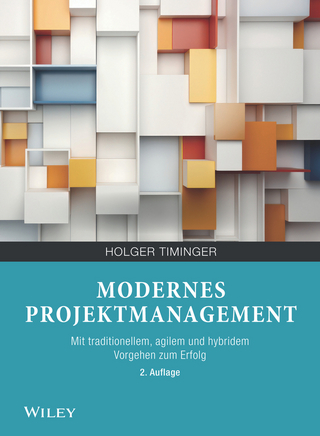
Successful Project Management
John Wiley & Sons Inc (Verlag)
978-0-471-68032-1 (ISBN)
The Fourth Edition of this internationally bestseller details the quick and easy way to master the basics of project management. Using a lively, conversational style, project management gurus Mickey Rosenau and Gregory Githens equip readers with fundamental principles and "tested-in-the-trenches" techniques for managing projects in any type of organization. They arm readers with easy-to-use tools for resolving any technical, mechanical, or personnel problem that may arise over the course of a project and break project management down into twenty-two chronological steps. Extensively revised and updated, this Fourth Edition examines the role of integration in project planning, risk-and-issues management, virtual teams, new theories, project management offices, and more! Successful Project Management, Fourth Edition is an ideal primer for students and an indispensable quick reference for experienced professionals.
MILTON D. ROSENAU, Jr. is well known in both project management and product development circles. He is the author of a number of successful books, including The PDMA Handbook of New Product Development and Successful Product Development (both published by Wiley). GREGORY D. GITHENS has more than twenty years of experience as a project and program manager, practitioner, consultant, and trainer. He held membership in the core team for both the 2000 and 2004 versions of PMI's PMBOK Guide. He is the cofounder of the new product development specific interest group within PMI and was a member of the editorial advisory board for PMNetwork magazine from 1995 to 2003.
Preface. 1. What Is a Project?
Projects Are a Type of Work.
Projects Distinguished From Tasks and From Processes.
Programs are Collections of Projects.
Project Management Maturity.
Integrated Project Management.
The Project Management “Hat” is Different From the Technical or Product Management “Hat”.
Effective Project Managers Manage Expectations of Stakeholders.
A Roadmap of Five Important Program Management Functions.
Highlights.
PART 1. DEFINING THE GOALS OF A PROJECT.
2. Linking the Project to the Product.
Strategic Alignment of Projects.
The Product Life Cycle and the Project Life Cycle.
Project Completion Includes Delivering a Result that Meets the Requirements.
The Delivering Organization and the Consuming Organization.
All Projects Involve Agreements.
Good Boundaries.
Taking Action.
Highlights.
3. Balancing Competing Demands with the Triple Constraint.
Many Ways to Measure Project Performance.
The Triple Constraint.
A Model to Help Evaluate Competing Demands.
Adjusting Baseline for Risk.
How the Triple Constraint Helps to Explain Three Common Tradeoffs.
The Triple Constraint During Control.
Other Examples of Balancing Competing Demands: Financial Management.
Project Management as a Decision-Making Process.
Highlights.
4. Contracts, Negotiations, and Proposals.
Contracts.
Negotiating the Contract.
Proposals: a Special Kind of Project.
The Proposal Process.
Typical Problems.
International Projects.
Highlights.
PART 2. PLANNING A PROJECT.
5. Why and How to Plan a Project.
Integrated Project Planning.
Using Computer Software During Project Planning.
"The Plan".
Applying Project Plans During Execution.
Project Planning is an Investment, Not an Expense.
Highlights.
6. The Work Breakdown Structure.
The Work Breakdown Structure.
The work Package and the WBS Dictionary.
Top-down Planning Approach for Developing the WBS.
Organizing the WBS for Completeness and Control.
Bottom-Up Planning Approach for Developing the WBS.
Validating the Work Scope.
Work Scope is Fundamental to Project Integration.
Highlights.
7. Scheduling.
Overview of Scheduling Formats.
Bar Charts.
Milestones.
Network Diagrams.
The Network Logic Diagram.
Why Use a Network Diagram?
Computer Software.
Helpful Hints.
Typical Problems.
Highlights.
8. Time Estimating and Compressing the Schedule.
Types of Time Estimates.
Earliest and Latest Start and Finish Times.
Typical Problems.
Highlights.
9. Cost Estimating and Budgeting.
Resource Planning.
Cost Estimating.
Project Cost System.
Budgeting Cost.
Computer Software.
Typical Problems.
Highlights.
10. The Impact of Limited Resources.
Resources.
Computer Software.
Time Versus Cost Trade-Off.
Typical Problems.
Highlights.
11. Risk and Contingency.
Ten Steps for Team-Based Risk Management.
Building a Culture for Good Decision Making.
Highlights.
PART 3. LEADING THE PEOPLE WHO WORK ON A PROJECT.
12. Organizational Design for Delivering Projects.
Three Organizational Forms.
Other Organizational Forms.
The Informal Organization.
Typical Problems.
Highlights.
13. Building the Project Team.
Core Team and Extended Team.
Staffing Starts with Project Scope.
Formal Project Authority.
Assigning Personnel to the Project.
Sources of Personnel.
Compromise.
Control.
Task Assignments.
The Virtual Project Team.
Turning a Group Into a True Team.
Computer Software.
Typical Problems.
Highlights.
14. Organizing the Support Team.
Involvement and Commitment.
Coordination.
Interaction With Support Groups.
Subcontractors.
Typical Problems.
Highlights.
15. The Role of the Project Manager.
Project Manager Competencies.
Project Management Career Path.
What a Project Manager Does.
Theories of Motivation and Their Implications.
Three Useful Techniques.
Typical Problems.
Highlights.
16. Practical Tips for Project Managers.
Communication.
Conflict Resolution.
Efficient Time Management.
Tips.
Typical Problems.
Highlights.
PART 4. CONTROLLING THE PROJECT.
17. Essential of Project Control.
Develop a Baseline.
Develop a Performance Measurement System.
Measure Performance Against Baseline and Determine Variances.
Forecasts.
Corrective Actions.
Multiple Projects.
Computer Software.
Typical Problems.
Highlights.
18. Project Reviews.
The Necessity for Reviews.
The Conduct of Reviews.
Periodic Reviews.
Follow-Up Actions.
Topical Reviews.
Typical Problems.
Highlights.
19. Project Cost Reports.
Cost Monitoring.
Computer Cost Reports.
Cost Monitoring Problems.
Earned Value Management.
Computer Software.
Typical Problems.
Highlights.
20. Handling Project Changes.
A Project Performance Track Record: Good or Bad?
The Process of Managing Changes.
Unmanaged Risks and Issues.
Typical Problems.
Highlights.
21. Solving the Inevitable Problems.
The General Approach.
Decision Trees.
Matrix Array.
Problem-Solving Meeting Styles.
Typical Problems.
Highlights.
PART 5. COMPLETING A PROJECT.
22. How to Complete a Project.
Winding Down the Project.
Acceptance.
Managing Scope Change.
Documentation.
Increasing Odds of Success.
Typical Problems.
Highlights.
23. Final Wrap-Up.
People Issues.
Lessons Learned and Audits.
Intellectual Property and Other Ownership Rights.
Typical Problems.
Highlights.
PART 6. OTHER ISSUES IN PROJECT MANAGEMENT.
24. Small Projects.
Simplified Management.
Problems.
Typical Problems.
Highlights.
25. New Product Development Projects.
Why New Product Development Projects Are Unique.
A General Framework.
Resource Overloading.
Typical Problems.
Highlights.
26. Project Management Software.
When and Where to Use Computer Project Management Software.
Cautions with Computer Project Management Software.
Other Software.
Typical Problems.
Highlights.
27. Where Do You Go From Here?
Summary.
Continuing Project Management Skill Development.
The Future of Project Management.
A Final Thought.
Appendix 1. Abbreviations Used in Project Management.
Appendix 2. Glossary of Project Management Terms.
Appendix 3. Examples of Planning Checklists for Project Managers.
Index.
| Erscheint lt. Verlag | 7.10.2005 |
|---|---|
| Zusatzinfo | Photos: 1 B&W, 0 Color; Drawings: 158 B&W, 0 Color; Tables: 14 B&W, 0 Color |
| Verlagsort | New York |
| Sprache | englisch |
| Maße | 160 x 236 mm |
| Gewicht | 680 g |
| Themenwelt | Technik |
| Wirtschaft ► Betriebswirtschaft / Management ► Projektmanagement | |
| ISBN-10 | 0-471-68032-X / 047168032X |
| ISBN-13 | 978-0-471-68032-1 / 9780471680321 |
| Zustand | Neuware |
| Informationen gemäß Produktsicherheitsverordnung (GPSR) | |
| Haben Sie eine Frage zum Produkt? |
aus dem Bereich


